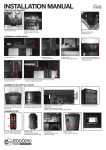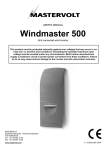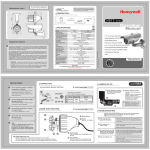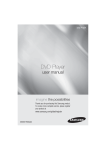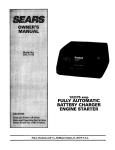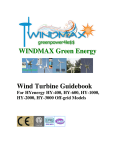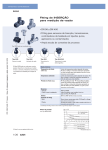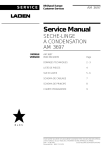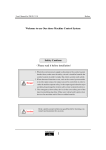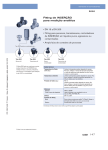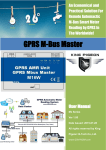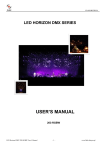Download PDF - Elster
Transcript
Turbine Gas Meter Automatic lubrication system INSTRUMENT INSTRUCTION MANUAL en Manual Automatic Lubrication System Eng. Rev.0 1 Revision History Revision Content of Change Document Pages total : Used Signs Sign Description Warning Indicates a procedure that has to be strictly followed as contravention may result in injury to personnel or loss of life Caution Highlights a procedure which, if not strictly followed , can result in injury to personnel or damage to equipment ) 2 Note Is an important element of the procedure and should be observed Manual Automatic Lubrication System Eng. Rev.0 en Contents 1 INTRODUCTION ........................................................................................................... 6 2 GENERAL DESCRIPTION ........................................................................................... 7 2.1 Operating principle ............................................................................................... 7 2.1.1 Working principle of the oil pump...................................................................... 8 2.1.2 Flow chart of the oil pump................................................................................. 9 3 INSTALLATION .......................................................................................................... 10 3.1 Start-Up................................................................................................................ 11 4 MAINTENANCE .......................................................................................................... 12 4.1 Periodic inspections........................................................................................... 12 5 TROUBLE SHOOTING ............................................................................................... 13 5.1 Refilling the oil reservoir.................................................................................... 14 6 DISMANTLING ........................................................................................................... 14 7 FURTHER INFORMATION ......................................................................................... 15 7.1 Publications by Instromet .................................................................................. 15 7.2 International Reference Material........................................................................ 15 7.3 OIML R6, General specifications for gas volume meters ................................ 15 7.4 OIML R32, Rotary piston meters and turbine gas meters ............................... 15 7.5 AGA report No. 7, Measurement of fuel gas by turbine meters. ..................... 15 8 TECHNICAL SPECIFICATION & PART IDENTIFICATION ....................................... 16 8.1 Technical specification Oil pump ...................................................................... 16 8.2 Technical specification Solenoid Valve ............................................................ 16 8.3 Technical specification Level-switch ................................................................ 16 8.4 Technical specification Pressure Regeulator................................................... 16 9 ATTACHMENTS ......................................................................................................... 17 9.1 Reverse Contact.................................................................................................. 17 9.2 Oil Frequency ...................................................................................................... 18 Connection diagramm .............................................................................................. 19 Description Solenoid type 6106............................................................................... 21 Operrating Instructions Solenoid type 6105/6106 ................................................... 25 en Manual Automatic Lubrication System Eng. Rev.0 3 Product information Pressure regulator type BB-1............................................... 31 9.5.1 Safety Instructions Pressure Reglator ............................................................ 32 9.5.2 Operation and Service manual Pressure regulator ........................................ 34 FIGURES Fig. 1 Automatic Lubrication System.......................................................................... 7 Fig. 2 Pump Automatic Lubrication system ................................................................ 8 Fig. 3 Principle flow chart ........................................................................................... 9 Fig. 4 Piston check.................................................................................................... 13 Fig. 5 How to Clean.................................................................................................. 14 Fig. 6 Detail lever-switch .......................................................................................... 17 4 Manual Automatic Lubrication System Eng. Rev.0 en In the design and construction of this equipment and instructions contained in this manual, due consideration has been given to safety requirements in respect of statutory industrial regulations. Users are reminded that these regulations similarly apply to installation, operation and maintenance, safety being mainly dependent upon the skill of the operator and strict supervisory control. en Manual Automatic Lubrication System Eng. Rev.0 5 1 INTRODUCTION The Instromet Turbine Gas Meter is a state of the art precision instrument, which measures the flow of gases by means of a turbine wheel. As extension to the known lubrication possibilities Instromet has developed an Automatic Lubrication System. With the line pressure and an electrical signal this system is able to lubricate the turbine gas meter independently. It will help to keep the turbine gas meter in the optimum working condition. The purpose of this manual is to provide a general guide to the installation, operation and care of automatic lubrication system for turbine gas meter. Every effort has been made to ensure that the information contained in this manual is as accurate as possible, however, the continuous improvements which Instromet makes to its products may result in small inconsistencies. Custom manufactured equipment or “specials” may also result in differences. It is highly recommended to use the Automatic lubrication system in combination with the Instromet Smart-Index providing the required signal. ) 6 It is therefore prudent to consult the specific technical data and other documents which accompanies the system. If in any doubt, Instromet should be contacted. Manual Automatic Lubrication System Eng. Rev.0 en 2 GENERAL DESCRIPTION ) 2.1 The automatic lubrication system must be considered a part of the pressure containing system. Operating principle The automatic Lubrication System consists of three main parts, pressure regulator (1), solenoid valve (2) and oil pump (3). The working principle of the pressure regulator and solenoid valve are described in the manuals from the suppliers, see attachments. In this part we will only describe the working principle of the oil pump. 1 2 3 Fig. 1 Automatic Lubrication System All other parts are described in See attachments en the attached company manuals. Manual Automatic Lubrication System Eng. Rev.0 7 2.1.1 Working principle of the oil pump 3 5 1 4 2 Fig. 2 Pump Automatic Lubrication system The oil pump consists of two main parts, as they are pump body and the piston assembly. This assembly consists of a pneumatic piston (2) and a hydraulic piston (3), see figure 2. By means of the 3/2 solenoid valve channel (1) is pressurised and de-pressurised. When pressurised the pneumatic piston is activated its force exceeded the spring setting and pulls the hydraulic piston into the housing. The locked quantity of lubrication in housing is transported trough the channel (4) to the turbine gas meter. De-pressurising the pneumatic piston will allow the spring to pull up the hydraulic piston again allowing the pump body to re-fill again for the next stroke. In order to detect a low oil level in the oil reservoir a low-level switch (5) is built in. This switch can be easily changed from NO (normally open) into NC (normally closed) by means of reverse mounting of the lever. For description see attachment Reverse Contact 8 Manual Automatic Lubrication System Eng. Rev.0 en 2.1.2 Flow chart of the oil pump 1 2 3 4 5 Fig. 3 Index Pressure tapping point Pressure regulator Safety valve Solenoid valve Oil pump Principle flow chart From the pressure tapping point the gas or compressed air is lead to the pressure regulator which is reducing the (line) pressure 7 upto 130 bar to 6 bar. An additional safety relief valve (3) is build in to protect the system. This relieve valve is be connected with the open air in case the line pressure is used. The solenoid valve (4) is also equipped with a button to allow manual lubrication. With this button the pump can be tested also. en Manual Automatic Lubrication System Eng. Rev.0 9 3 INSTALLATION Installation only by authorised skilled people. International, national, local and company safety rules are to be strictly followed as contravention may result in injury to personnel or loss of life. Factory settings of pressure regulator and pressure relieve valve are not to be changed. Recommended way of connecting to a turbine gas meter is described in Technical Note TN-11.368 If the meter is located in a zone classified as hazardous, all connections must be to intrinsically safe circuits. Connect the (line) pressure or compressed air to the pressure regulator inlet marked with “in”. Verify if the outlet pressure from the regulator is appropriate to the intended application. Fill the oil reservoir with the oil delivered with the turbine gas meter. The oil should be clean and free of liquids, dust or foreign material, which could damage the automatic lubrication system. 10 Manual Automatic Lubrication System Eng. Rev.0 en 3.1 Start-Up At the first use external oil pipes has to be filled-up with oil. This has to be done by a predicted number of manual strokes using the button on the solenoid. Each push is one stroke. In order to estimate the required number of strokes the equation below can be used. Number lubrications = ( L / 8 ) + V Where: L = the length of the external oil piping in cm V = additional volume inside meter body as a factor depending on size Size V 50 / 2” 1 80 / 3” 1 100 / 4” 3 150 / 6” 4 200 / 8” 4 250 / 10” 7 300 / 12” 8 400 / 16” 10 500 / 20” 12 600 / 24” 14 Lubricate the turbine gas meter with the required strokes by pushing the red button on the solenoid valve and checking the hydraulic piston is moving at each strokes. Close the oil reservoir. Adjust the right lubrication frequency at the Smart-Index. See manual Smart Index. Lubrication frequency for normal use is given in attachment Oil Frequency en Manual Automatic Lubrication System Eng. Rev.0 11 4 MAINTENANCE It is not allowed to carry out any repair or maintenance during use. The turbine gas meter operates under pressure and / or at dangerous mediums. The turbine gas meter can be in operation at high or low temperature. Due to this fact the turbine gas meter can turn very hot or cold and touching can cause serious injuries. 4.1 Periodic inspections No inspection (of the lubrication system) can be done while the system is activated. The gas stream should be clean and free of liquids, dust or foreign material, which could damage the meter rotor and mechanism. A correct functioning of the piston can be checked by measuring “L”, with a clean slide gauge, the distance between hydraulic piston and the top of the oil reservoir, see figure 4 Fig. 4 12 Piston check Manual Automatic Lubrication System Eng. Rev.0 en Operate button manual and measure the distance L again. The difference between the two measurements must be 26 ±1 mm. If the distance is less the system is not working correct and needs maintenance. 5 TROUBLE SHOOTING No inspection and or maintenance (of the lubrication system) can be done while the system is activated. Check the working pressure of the automactic lubrication system. This is the outlet pressure of the pressure regulator it must 6 bar. Measure the distance L again as described above. If the required distance is not achieved the cilinder inside (1) has to be cleaned and greased again. Remove cable gland (2) from oil-level switch, untight 4 crews (3) and remove the bottom, see figure 5. 1 3 2 4 Fig. 5 How to Clean Clean the cilinder inside and grease with Molykote 55M or equal. Mount all parts and perform 10 manual strokes. At the last stroke the distance L should measured again. If the distance L is still to smal the “back” pressure from the turbine gas meter may be to high. This is to verify by removing the oil pipe (4) at the bottom side of the lubrication system see figure 5. Please collect the released oil and discharge it in the correct way. en Manual Automatic Lubrication System Eng. Rev.0 13 Perform a manual stroke again and measure the distance L again. If the distance is correct the check valve of the turbine gas meter is the problem. Otherwise the automatic lubrication system is defect. 5.1 Refilling the oil reservoir The oil reservoir has to checked and refilled regularly. See attachment 9.2 Before refilling verify the remaining oil is clean. If not, the remaining oil should be discharged in a proper way. To discharge the remaining oil the drain at the bottom of the oil reservoir can be opened or the pump has to be dismantled. 6 DISMANTLING Before a meter may be dismantled or removed from the installation, the line must be de-pressurised. It is important that the line is de-pressurised slowly and with care to prevent damage to the turbine and bearings. See manual turbine gas meter The measuring line should be at ambient temperature before the gas meter is removed. The oil reservoir has to checked and the remaining oil should discharged on a proper way. To discharge the remaining oil the drain at the bottom of the oil reservoir can be opened or the pump has to be dismantled Dismantling the pump by: Remove (line) pressure or compressed air from the system Remove the pressure connection Remove the electrical connection Dis-assamble the pump from the turbine gas meter by removing the 2 M8 bolts Remove the remaining oil from the reservoir and discharge it on a proper way 14 Manual Automatic Lubrication System Eng. Rev.0 en 7 FURTHER INFORMATION 7.1 Publications by Instromet Turbine Gas Meter Handbook P-Meter Handbook: Turbine Meters for Ethylene 7.2 International Reference Material International standards: ISO 9951: 1993, Measurement of gas flow in closed conduits – Turbine meters. Recommendations of the International Organisation of Legal Metrology: 7.3 OIML R6, General specifications for gas volume meters 7.4 OIML R32, Rotary piston meters and turbine gas meters American Gas Association: 7.5 AGA report No. 7, Measurement of fuel gas by turbine meters. en Manual Automatic Lubrication System Eng. Rev.0 15 8 TECHNICAL SPECIFICATION & PART IDENTIFICATION 8.1 Technical specification Oil pump Materials Body material Piston and Spring Seals Temp. range Max. oil pressure Content reservoir Capacity / stroke Connecetion : : : Aluminium anodized Stainless steel NBR : : : : : 263.15 – 333.15 K ( -10 / +60° C) 10 M pa (100 bar) 175 cc 1.5 cc 6mm Swagelock 8.2 Technical specification Solenoid Valve Power supply Powerconsumption Protection class Ex approval class Min. puls Min. delay time : : : : : : 24V ± 10% 0.5 W IP65 II 2G EEx ia IICT5 or T6 ( Old - EEx ia IIC6T) 3 sec 5 sec (resting time) For furhter informations and instructions see: Operating Instructions Bürkert Function descriptions Solenoid valve Type 6106 8.3 Technical specification Level-switch Material Switch Execution Max. current Max. voltage : : : : : Polyamide Reed switch NC (standard) or NO 0.5A 200V 8.4 Technical specification Pressure Regeulator For further information and instructions see: Tescom technical information Tescom Operatiing and servicemanual Tescom safety, Installation & Operation precautions 16 Manual Automatic Lubrication System Eng. Rev.0 en 9 ATTACHMENTS 9.1 Reverse Contact If required the oil-level switch, which is Normaly Open, can be changed into Normaly Closed version. Fig. 6 en Detail lever-switch - Prepare your tools to be clean - Open the reservoir by removing the reservoir cap. - Remove ring (1) figure 7 - Take the level-body (2) from the pilar - Place the level-body upside down - Replace ring (1) - Test the sensor - Close the reservoir with the cap again Manual Automatic Lubrication System Eng. Rev.0 17 9.2 Oil Frequency Lubricating frequency of Instromet trubine gas meters Size 50 / 2” 80 / 3” 100 / 4” 150 / 6” 200 / 8” 250 / 10” 300 / 12” 400 / 16” 500 / 20” 600 / 24” 18 Lubricatio 1 x per …. Days 60 60 60 60 60 60 60 60 60 60 Lubrication quantity (cc) 1.5 3 3 4.5 4.5 7.5 7.5 9 12 12 Reservoir refill 1x per …. year 5 5 5 5 5 3 3 3 2 2 Manual Automatic Lubrication System Eng. Rev.0 en 9.3 Connection diagramm en Manual Automatic Lubrication System Eng. Rev.0 19 20 Manual Automatic Lubrication System Eng. Rev.0 en 9.4 Description Solenoid type 6106 22 Manual Automatic Lubrication System Eng. Rev.0 en en Manual Automatic Lubrication System Eng. Rev.0 23 24 Manual Automatic Lubrication System Eng. Rev.0 en en Manual Automatic Lubrication System Eng. Rev.0 25 9.4.1 Operrating Instructions Solenoid type 6105/6106 26 Manual Automatic Lubrication System Eng. Rev.0 en en Manual Automatic Lubrication System Eng. Rev.0 27 28 Manual Automatic Lubrication System Eng. Rev.0 en en Manual Automatic Lubrication System Eng. Rev.0 29 30 Manual Automatic Lubrication System Eng. Rev.0 en en Manual Automatic Lubrication System Eng. Rev.0 31 9.5 Product information Pressure regulator type BB-1 32 Manual Automatic Lubrication System Eng. Rev.0 en 9.5.1 Safety Instructions Pressure Reglator en Manual Automatic Lubrication System Eng. Rev.0 33 9.5.2 Operation and Service manual Pressure regulator 34 Manual Automatic Lubrication System Eng. Rev.0 en 9.5.3 Operation and Service manual pressure regulator en Manual Automatic Lubrication System Eng. Rev.0 35 36 Manual Automatic Lubrication System Eng. Rev.0 en



































